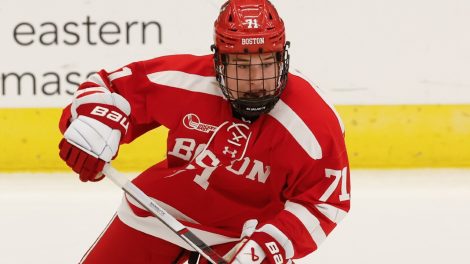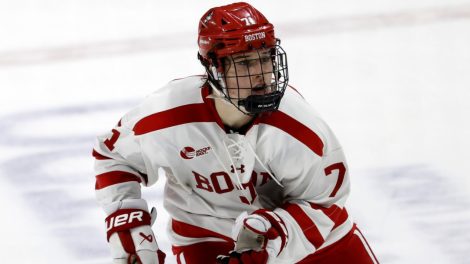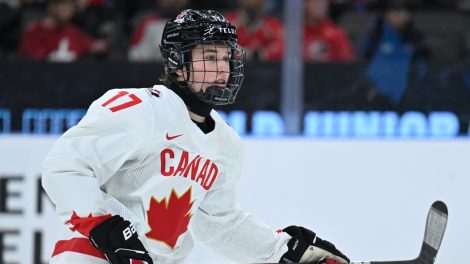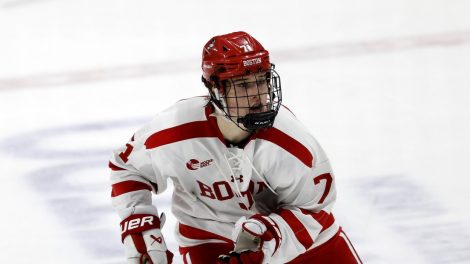This article was originally published prior to the 2015 NHL Draft.
You could argue the most telling and informative element about the entire trade was the second deal that happened after Mats Sundin was moved to the Maple Leafs on the morning of the 1994 NHL draft in Hartford.
The first one was, of course, earth-shaking enough.
“They wouldn’t let me into bars and restaurants in Toronto,” jokes Cliff Fletcher more than two decades later about the trading of Leaf captain Wendel Clark.
It was a very different time. Big deals were much more possible, more teams were owned by a single proprietor and the relationships between general managers often spanned decades, allowing them to make snap decisions without consulting another soul.
[snippet id=3816507]
So before we retell how Sundin became a Leaf and Clark a Quebec Nordique on the draft floor back on June 28, 1994, the kind of dramatic swap some think could happen this week before Friday’s draft in Florida, consider what happened immediately after the 1994 trade, which sent Sundin, prospect Todd Warriner, defenceman Garth Butcher and Quebec’s first round choice (10th overall) to the Leafs for Clark, defenceman Sylvain Lefebvre, prospect Landon Wilson and Toronto’s first rounder (22nd overall).
TIMES WERE DIFFERENT
It so happened that a few days before the ’94 draft the chief scout of the Leafs, Pierre Dorion Sr., had suddenly died at the age of 49, leaving the club’s drafting plans uncertain. With the 10th pick (initially acquired by Quebec in the Lindros deal with Philadelphia), Fletcher had his eye on drafting Brett Lindros after making a serious pitch for his older brother, Eric, two years earlier when the Nords put him up for auction.
The Nordiques actually owned both the No. 9 and No. 10 picks.
“As I walked in the arena, I saw Eric Lindros, and he said, you’re not gonna take my brother, are you?” says Sherry Bassin, who was then an assistant GM with the Nordiques.
The Leafs figured that was the area in which the younger Lindros, a winger with the OHL Kingston Frontenacs, would be taken.
“Cliff had fallen in love with Brett Lindros. But there was no way Quebec would trade us the ninth pick,” recalls former Leaf assistant GM Bill Watters. “We found out why.”
At the last moment, the Nordiques swapped the No. 9 pick to the Islanders for defenceman Uwe Krupp and the 12th pick, which they used to select the late Wade Belak. The Isles then drafted the younger Lindros brother. Stunned, Fletcher listened in as his scouts debated the merits of turning their attention to winger Jeff Friesen, a 51-goal scorer with the WHL Regina Pats.
“I got tired of listening, so after a while I walked over to (Washington GM) David Poile and said, ‘Want to make a deal?’,” recalls Fletcher. “So right there we flipped picks and we got Mike Ridley in a trade. Then we drafted the goalie, Eric Fichard, which didn’t really work out for us, either.”
It was that simple then to make a trade. Just walk over and make a proposal. The salaries were lower, so each deal wasn’t a multi-million dollar affair, and there was no salary cap to limit the possibilities.
“You could make more things happen then,” said Fletcher. “Things are much more different now for GMs than when I was doing the job. Things just don’t happen like they used to. In the old days, you could make a deal. Now, it’s like you have to match dollar-for-dollar.”
Indeed, the Sundin-Clark deal was, in its essence, a simple hockey trade. The Leafs had lost back-to-back Western Conference finals and were looking for a big change, another centre to help star pivot Doug Gilmour up the middle.
The Nordiques had lost to Montreal in the ’93 playoffs and then missed the post-season entirely in ’94. They wanted toughness and defence, plus since they also owned Joe Sakic, Peter Forsberg and Mike Ricci, they felt they could and should move one of their young centres.
So a blockbuster was born.
THE LEAFS WANTED MIKE RICCI
How exactly it happened, well, time has fogged the mirror to some extent. It’s become a bit of a ghost story from a place (Hartford) that no longer exists on the NHL map, and the long cast of characters involved each has their own version, it seems.
For the Leafs, there were Fletcher and Watters, both long-time, colourful hockey men who had resuscitated the moribund Leafs by swinging a series of flamboyant trades, including bringing in Gilmour in a mammoth 10-player deal and adding stars like Grant Fuhr and Dave Andreychuk along the way.
For Quebec, there was owner Marcel Aubut, who would sell the team to Denver interests a year later and had traded Eric Lindros for a bundle of players, prospects, draft picks and cash. A month before the 1994 NHL draft, Aubut fired GM and head coach Pierre Page, and replaced him with hockey agent Pierre Lacroix. Sherry Bassin, who had advised Aubut on the Lindros trade, was still an assistant GM with the club as well, adding another voice to the retelling of this tale.
How the trade exactly came together depends on who you talk to. Fletcher recalls mostly dealing with Lacroix. Watters thinks the final negotiations were over money between Fletcher and Aubut. Bassin says he quarterbacked the deal, talking to Fletcher and Watters at different times, and says the genesis of the deal came the previous winter when he was scouting at Maple Leaf Gardens and the Leafs asked about acquiring Ricci.
“We started talking, and I said to Cliff, ‘I’m gonna mention one name to you, and if it gets out I’ll never trade him to you,’” says Bassin. “That was Sundin. Cliff’s eyes got bigger. I said the two guys we would want would be Clark and Lefebvre.
“Cliff said, ‘Are you f—-ing crazy? If I put Clark’s name in the deal, you might as well put mine in there, too, because they’ll run me out of town.”
Warriner was supposed to be a big part of Quebec’s future, and that season was part of Team Canada at the Winter Olympics in Lillehammer, Norway when he got an indication something might be up.
“Cliff Fletcher made a point of meeting my parents in Lillehammer, telling them he thought a lot of their son,” says Warriner. “My dad thought that was a bit odd. It made more sense later.”
Clark, meanwhile, had just finished a 46-goal season and seemed untouchable as a local hero. But months passed, the deal percolated, and then Lacroix came aboard. The final deal between the clubs was struck either in person on the night before the trade – Bassin’s version – or on the draft morning – Fletcher’s version – as the Leaf brass prepared to leave their hotel for the Hartford Civic Centre.
“I remember seeing (Clark’s agent) Don Meehan over by the boards in the arena and I told him we’d traded Wendel. I thought he was going down for the count,” chuckles Fletcher. “Did I want to trade Wendel? Of course not. But the trade, in my mind, was so overwhelmingly favourable for us that in clear conscience I couldn’t not make it.”
It was, for the most part, a brilliant trade for Fletcher, one of his best. Sundin played 13 seasons for the Leafs, became the team’s captain, led the club to a pair of Eastern Conference final appearances and is a member of the Hockey Hall of Fame.
“What’s underrated is that he was a great captain,” says Fletcher. “He challenged our players.”
Butcher played 45 games for the Leafs and retired. Warriner, the fourth overall pick in the ’92 draft, scored 36 goals for the Leafs over the next six seasons before being dealt to Tampa Bay.
“I’d been to two Quebec camps, and I thought I was in their plans,” he says. “But I thought the trade was great for me. I was thrilled to come to Toronto, although I remember thinking, I wish Wendel was there. I’d got to know him because I’d been coached by Brad (Motor City Smitty) Smith, and he and Wendel were friends. So I knew Wendel, too.”
Fichaud, finally, was traded to the Islanders a year later in a deal for Benoit Hogue and never played for the Leafs.
CLARK LEARNED OF TRADE AT A GAS STATION
On the Nordiques side, Clark only played one season for Quebec and when the team was moved to Denver, he was traded to the Islanders in a three-way swap that brought Claude Lemieux to the Avs and sent Steve Thomas to New Jersey.
He heard about the original trade from Toronto to Quebec while at an Esso station in downtown Toronto when he turned on the radio to see who the Leafs had drafted in the first round.
“I had no idea I was going to be traded,” he says. “I’d had my best season, and that year I’d probably heard the fewest amount of trade rumours involving me.
“I was surprised. But you can’t always live in a perfect world.”
Fletcher reacquired him for the Leafs in March, 1996 in a deal that sent the Islanders defenceman Kenny Jonsson and the fourth pick in the draft, which Long Island used to select goalie Robert Luongo.
“Wendel was so popular I had to bring him back,” says Fletcher. “When I made that deal I made the “draft schmaft” comment. I thought I was saying it in fun, but it sure came to bite me in the ass.”
Lefebvre played five seasons for the Nordiques/Colorado Avalanche and was part of the Cup-winning squad in 1996. Wilson had been a first round pick of the Leafs (19th overall) in ’93 out of the University of North Dakota and ended up playing 375 NHL games, but only 16 for Colorado. Jeff Kealty was a defenceman drafted by the Nordiques with the 22nd pick out of Boston University and never played an NHL game.
It was a significant trade in terms of bodies, but probably more so for the hockey history involved, the colourful nature of the players in the deal and the men who made it happen, and the fact it happened in dramatic style, announced on the floor of the draft for maximum impact.
Clark was a beloved figure in Toronto, a Saskatchewan farm boy who had set the town on its ear. Sundin was a true star, and a pioneer as the first European drafted first overall into the NHL.
Both teams believed the trade would significantly alter their futures. But only Lefebvre, a quiet, stay-at-home defenceman, ended up capturing a Stanley Cup ring, and that was after Quebec lost its NHL franchise.
There are big names being bandied about this week in NHL circles. But one doubts we’ll see a deal that will arrive with a bang like that one did back in ’94.






